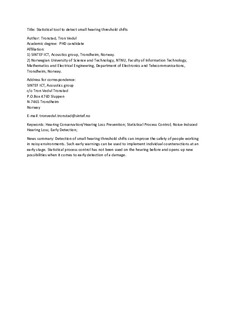| dc.contributor.author | Tronstad, Tron Vedul | |
| dc.date.accessioned | 2017-09-25T08:44:23Z | |
| dc.date.available | 2017-09-25T08:44:23Z | |
| dc.date.created | 2017-05-16T09:58:41Z | |
| dc.date.issued | 2017 | |
| dc.identifier.citation | International Journal of Audiology. 2017, 56 (8), 596-606. | nb_NO |
| dc.identifier.issn | 1499-2027 | |
| dc.identifier.uri | http://hdl.handle.net/11250/2456474 | |
| dc.description.abstract | Objective: The aim of this study is to present a new tool that can be used in the prevention of noise-induced hearing loss. Even in most countries where noise levels are well regulated, many workers are still exposed to high levels of noise and suffer from permanent threshold shifts. It is necessary to develop a new strategy to prevent such damage. Method: A statistical process control (SPC) scheme is presented that is able to detect both large and small hearing threshold shifts. Monte Carlo simulations were used to assess the performance of this hearing monitoring scheme. Different hearing threshold shifts were simulated to evaluate the performance of a variety of hearing development scenarios. Results: It is possible to detect hearing threshold shifts smaller than the standard deviation of the hearing tests performed. This means that permanent hearing threshold shifts smaller than 5 dB can be detected and acted on. Outliers can also be automatically detected and treated, increasing the robustness of the monitoring scheme. Conclusion: The proposed statistical framework can be used as an early warning indicator of noise-induced hearing loss with the aim of improving workers’ safety. Individual counteractions can be implemented, reducing the risk of further damage. | nb_NO |
| dc.language.iso | eng | nb_NO |
| dc.publisher | Taylor & Francis | nb_NO |
| dc.title | Statistical tool to detect small hearing threshold shifts | nb_NO |
| dc.type | Journal article | nb_NO |
| dc.type | Peer reviewed | nb_NO |
| dc.description.version | acceptedVersion | nb_NO |
| dc.source.pagenumber | 596-606 | nb_NO |
| dc.source.volume | 56 | nb_NO |
| dc.source.journal | International Journal of Audiology | nb_NO |
| dc.source.issue | 8 | nb_NO |
| dc.identifier.doi | 10.1080/14992027.2017.1303203 | |
| dc.identifier.cristin | 1470424 | |
| dc.description.localcode | This is an Accepted Manuscript of an article published by Taylor & Francis in International Journal of Audiology on 23 Mar 2017, available online: http://www.tandfonline.com/doi/full/10.1080/14992027.2017.1303203 . Locked until 23 Mar 2018 due to copyright restrictions | nb_NO |
| cristin.unitcode | 194,63,0,0 | |
| cristin.unitname | Fakultet for informasjonsteknologi, matematikk og elektroteknikk | |
| cristin.ispublished | true | |
| cristin.fulltext | postprint | |
| cristin.qualitycode | 1 | |
